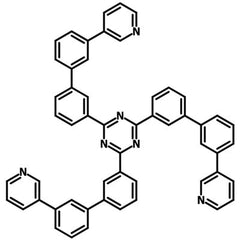TmPPPyTz
CAS Number 939430-31-6
Dopant Materials, High Purity Sublimed Materials, Materials, OLED Materials, Semiconducting MoleculesElectron Transport Layer Material with Triazine Core
High purity sublimed electron deficient material for highly efficient TADF-OLEDs
TmPPPyTz (CAS number 939430-31-6), namely 2,4,6-tris(3'-(pyridin-3-yl)biphenyl-3-yl)-1,3,5-triazine, has a wheel-shaped structure with 1,3,5-triazine core and three side arms of 3-pridylbiphenyl, and pyridines on the peripheral. It is highly electron deficient thus used as electron transport layer (ETL), hole blocking layer (HBL) material in highly efficient light-emitting diodes.
Hole-blocking ETL material
Hole-blocking ETL material in OLEDs
Worldwide shipping
Quick and reliable shipping
High purity sublimed material
>99%
Unique molecular confirmation
wheel shaped molecule
Device with platinum(II) complexes bearing tetradentate ligand with a bridging tertiary amine (tetra-Pt-N) as the active layer material with double-host TCTA:B3PYPM, and B3PYPM as the interlayer between the emissive layer and TmPPPyTz as the electron-transport layer, achieved a maximum power efficiency of over 100 lm/W, a low turn-on voltage of less than 2.5 V and low efficiency roll-off.
TmPPPyTz has a similar structure to 3N-T2T which tends to form exciplex with electron donor as co-host or emitting layer material.
General Information
| CAS number | 939430-31-6 |
|---|---|
| Chemical formula | C54H36N6 |
| Molecular weight | 768.9 g/mol |
| Absorption* | λmax 251 nm (in DCM) |
| Fluorescence | λem (n.a.) |
| HOMO/LUMO | HOMO = 6.63eV, LUMO = 3.09 eV |
| Synonyms | 2,4,6-Tris(3'-(pyridin-3-yl)biphenyl-3-yl)-1,3,5-triazine |
| Classification / Family | Triazine derivatives, Electron transport layer (ETL), Hole blocking layer (HBL), Sublimed materials. |
Product Details
| Purity | Sublimed* >99% (HPLC) |
|---|---|
| Melting point | TGA: Td > 400° C. (5% weight loss) |
| Appearance | Off white crystals/powder |
* Sublimation is a technique used to obtain ultra pure-grade chemicals, see sublimed materials for OLED devices.
Chemical Structure

Device Structure(s)
| Device structure | ITO/MO3/TCTA:B3PYPM: tetra-Pt-N* (18 nm)/B3PYMPM (10 nm)/TMPPPYTZ (40 nm)/LIF/Al [1] |
|---|---|
| Colour |
|
| Max Current Efficiency | 87.2 cd/A |
| Max EQE | 23.2% |
| Max. Power Efficiency | 102.8 lm W-1 |
| Device structure | ITO/TcTa:MoOx (40 nm, 15 wt.%)/TcTa (10 nm)/TcTa:10 wt.% FIrpic (5 nm)/TmPPPyTz:10 wt.% FIrpic (5 nm)/TmPPPyTz (40 nm)/Cs2CO3 (1 nm)/Al [2] |
|---|---|
| Colour |
|
| Max Current Efficiency | 26.9 cd/A |
| Max EQE | 13.3% |
| Max. Power Efficiency | 32.5 lm W-1 |
| Device structure | ITO/TcTa:MoOx (40 nm, 15 wt.%)/TcTa (10 nm)/TcTa:6 wt.% Ir(ppy)3 (5 nm)/TmPPPyTz:6 wt.% Ir(ppy)3 (5 nm)/TmPPPyTz (40 nm)/Cs2CO3 (1 nm)/Al [2] |
|---|---|
| Colour |
|
| Max Current Efficiency | 48.7 cd/A |
| Max EQE | 14.3% |
| Max. Power Efficiency | 58.8 lm W-1 |
| Device structure | ITO/TcTa:MoOx (40 nm, 15 wt.%)/TcTa (10 nm)/TcTa:8 wt.% Ir(MDQ)2(acac) (5 nm)/TmPPPyTz:8 wt.% Ir(MDQ)2(acac) (5 nm)/TmPPPyTz (40 nm)/Cs2CO3 (1 nm)/Al [2] |
|---|---|
| Colour |
|
| Max Current Efficiency | 20.1 cd/A |
| Max EQE | 13.7% |
| Max. Power Efficiency | 24.9 lm W-1 |
*For chemical structure information, please refer to the cited references.
Pricing
| Grade | Order Code | Quantity | Price |
|---|---|---|---|
| Sublimed (>99% purity) | M2419A1 | 100 mg | £210 |
| Sublimed (>99% purity) | M2419A1 | 250 mg | £420 |
| Sublimed (>99% purity) | M2419A1 | 500 mg | £730 |
| Sublimed (>99% purity) | M2419A1 | 1 g | £1100 |
MSDS Documentation
Literature and Reviews
-
High-performance organic light-emitting diodes with low-efficiency roll-off using bulky tetradentate [Pt(O^N^C^N)] emitters, M. Mao et al., J. Mater. Chem. C, 7, 7230-7236 (2019); DOI: 10.1039/C9TC00682F.
-
Low driving voltage blue, green, yellow, red and white organic light-emitting diodes with a simply double light-emitting structure, Z. Zhang et al., Opt. Express, 22 (2), 1815-1823 (2014); DOI: 10.1364/OE.22.001815.
-
Carbazole-based Multiple Resonance Dendrimers with Narrowband Blue Emission for Solution-Processed OLEDs, J. Liu et al., Chinese J. Polym. Sci., 41, 802–810 (2023); DOI: 10.1007/s10118-023-2977-4.

 TmPPPyTz MSDS Sheet
TmPPPyTz MSDS Sheet